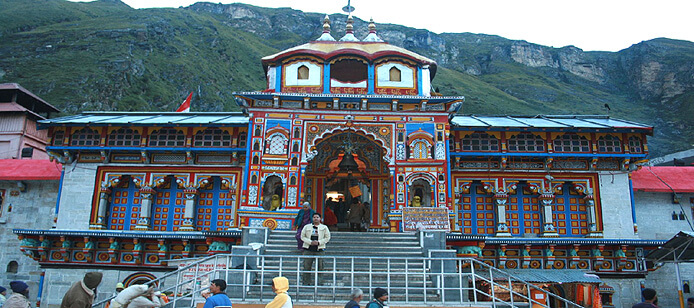| |
 It is one of the four destinations that constitute the chardham, a sacred
pilgrimage for every devout Hindu. Located in the Chamoli district of Uttarakhand in northern India, Badrinath also happens to be the most revered of the four sacred shrines in Garhwal, the other three being Yamunotri, Gangotri and Kedarnathji. The Himalayan town occupies a place on the banks of the River Alaknanda and is located at an altitude of 3,133 m above sea level. The Badrinath shrine is dedicated to Lord Vishnu, considered to be the preserver of the universe in the Hindu mythology. The original structure of the temple was destroyed many times due to avalanches. The structure was restored in the 19th century by the royal houses of Scindia & Holkar. The temple complex at Badrinath 15 idols, wonderfully carved out of black stone. It is one of the four destinations that constitute the chardham, a sacred
pilgrimage for every devout Hindu. Located in the Chamoli district of Uttarakhand in northern India, Badrinath also happens to be the most revered of the four sacred shrines in Garhwal, the other three being Yamunotri, Gangotri and Kedarnathji. The Himalayan town occupies a place on the banks of the River Alaknanda and is located at an altitude of 3,133 m above sea level. The Badrinath shrine is dedicated to Lord Vishnu, considered to be the preserver of the universe in the Hindu mythology. The original structure of the temple was destroyed many times due to avalanches. The structure was restored in the 19th century by the royal houses of Scindia & Holkar. The temple complex at Badrinath 15 idols, wonderfully carved out of black stone.
History of Badrinath
As to the age, there are no historical records are available of this holy temple, however reference to the Lord Badri Nath has been made in Vedas, the holy book of the Hindus. The temple is situated on the banks of the Alaknanda River in the lap at the Narain Parvat, near a hot water spring-the Tapta Kund. The temple was worshipped as a Buddhist temple, when King Ashoka was the ruler of India, but according to Skand Puran the idol of Lord Badrinath was recovered by Adiguru Shankaracharya from Narad Kund and was re-enshrined in the 8th century A.D. in this temple. The idol of Lord Vishnu (Badri Nath) is made of black stone (Shaligram) and seated in a Padmasan Posture. Devotees can see the idol of Lord Badri Nath as Brahma, Vishnu, Mahesh, Hanuman, Kali or Guru, in what so ever form they wish to see the almighty, all pervading and all in one.
The temple is divided into three parts. The garbh griha in which the idol of Lord Badrinath is seated in the inner part of this place and canopy covered with gold sheet. Second part is known as Darshan Mandap in which puja ceremonies are performed. Third part is the Sabha Mandap, which is an outer hall, where devotees wait for darshan of Lord Badrinath. Darshan of Lord Badrinath is available in Sabha Mandap at 6:30 A.M. to 13:00 Noon and 4:00 P.M. to 9:00 P.M.
The chanting of Vedic Hymns together with the chiming of bells creates a heavenly atmosphere in the temple. Pilgrims can join the puja ceremony after a dip in the Tapta Kund. Some of the morning pujas are - Mahabhishek, Adhishek, Gitapath and Bhagwat Path, while the evening pujas are Geet Govind and Aarti.
Geographic Details of Badrinath
Altitude: 3133mts
In summers: Cool during day and cold at night.
In winters: Very cold, about to touching sub zero
Clothing required
April to July - Light woolen.
September to November - Heavy woolens

Distance Chart
|
Rishikesh to Haridwar
Rishikesh to Deoprayag
Deoprayag to Srinagar
Srinagar to Rudraprayag
Rudraprayag to Karanprayag
Karanprayag to Nandprayag
Nandprayag to Chamoli
Chamoli to Pipalkoti
Pipalkoti to Joshimath
Joshimath to Badrinath
|
- 24 kms
- 70 kms
- 33 kms
- 36 kms
- 31 kms
- 21 kms
- 10 kms
- 17 kms
- 31 kms
- 45 kms
|
|









